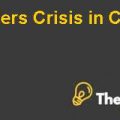BACKGROUND OF THE COMPANY
Mobil Corporation is basically one of the largest three companies in the gas, oil and petrochemical industry, with its headquarters in Fairfax Virginia. The company consists of 5 major divisions and its sales growth has been almost 5% over the past 5 years. In 1994 the company was decentralized so that its employees can develop closer relationships with its customers. The company has been transformed to a functional organization and now its required a new system of measurement to be developed. It was then that a balance scorecard was proposed to Bob McCool, the executive vice president of Mobil Corporation and the project was launched in 1994 and by May 1994 the model was developed.
After the scorecard was implemented all the divisional heads were responsible to meet the requirement of the scorecard. The main problems that led to the development of this model were that the company had resulted poor financial results in 1991 and 1992. The company incurred a loss of $ 145 million. This was all due to poor controls, no proper unified policies and bad organizing. However, now the effectiveness of the controls and this model depended upon, the level of profit such as the return on capital employed. The balance scorecard proved to be successful model for Mobil Corporation and it had boosted the value of the company and this led to a positive assessment by the company’s investors.
ASSESSMENT OF THE ISSUES FACED BY MOBIL CORPORATION
The main issues faced by the company related to the financial performance and the internal controls of the company. There was significant decrease in the profits of the company not just compared to its competitors but also the industry averages. It had incurred $ 145 million in losses in the year 1992. However, to address the issues strategic divisions were formulated and the divisions of the company were organized functionally. This had introduced some improvements but still a new measurement system was needed. The old metrics of the company such as distribution operations, low cost for manufacturing and availability for dealer-based operations were not giving the true picture of the company’s operational results. Therefore, the balanced scorecard model was developed by the company in 1994. After the implementation of this model, the financial results of the company had significantly improved. Another measure of performance of the effectiveness of implementation of balance scorecard is the change in the price of the stocks of the company. Earning per share results could also be used to measure the effectiveness. The balance scorecard had for sure improved the operations of the company. However, the another problem was that it was really difficult to analyze that at what extent the balanced scorecard approach has affected positively on the performance of the company and how much the results were dependent upon market trends. For instance, if the increase in the level of stock is used to analyze the effectiveness of this model, then there is a considerable risk of error due to speculative transactions being carried out in the capital markets.
ANALYSIS OF THE ISSUES
The company had incurred a loss of $145 million in 1992. There were many reasons and causes of such poor performance. There was lack of unified policies and lack of control by the management. The employees of the company had begun to experience internal reporting problems. The policies that were being established by the top management were hindering innovation and creativity in the company. Administrative processes had also contributed to this problem. The main issue was that the company was centralized. The costs for the company were increasing and the profits were declining even before the industry averages. Also because the organization was decentralized and the strategy of the company was also unclear, and due to these problems the customer service level was low, the company’s costs were increasing and the brand image of the company was also undesired at that time. The operations of the company were not being measured properly. This was due to lack of management involvement and also the identification of wrong measurement metrics to assess the problems in the company’s operations. The metrics of the company included low cost for distribution operations, low cost of manufacturing, volume for marketing operations, safety and environmental indicators and also health and safety. However, the company failed to perform right operationalization for these metrics. Also one of the most important cause of the deteriorating financial results was that the management of the company had inadequate control over the changes in the individual process results and also their causes.
RECOMMENDATIONS AND CONCLUSION
Now, that the company had implemented the balanced scorecard model, the management of the company needs to monitor the results of the company’s operations. When this model was implemented, the financial results of the company had improved greatly...............
This is just a sample partial case solution. Please place the order on the website to order your own originally done case solution.
General director for marketing and processing division of a major oil company in the midst of implementing profit turnaround. It transforms the highly centralized, organized functionally divided into 17 independent business units and 14 domestic suppliers. The department also runs the new market segmented strategy for high-end customers. The Director-General recognizes, however, that the new organization and strategy will require a new measurement system. He turns to the Balanced Scorecard (BSC) because of its ability to link the measurement strategy, and to help new profit center managers to develop individual strategies for their local responsibilities. The case describes the development of the initial division of SSP, the link polling BSC for independent business unit and internal BBB Service Company, and the connection to the BSC compensation managers. Concludes with managers thinking about how they use the BSC in their management processes. "Hide
by Robert S. Kaplan Source: Harvard Business School 19 pages. Publication Date: September 5, 1996. Prod. #: 197025-PDF-ENG














